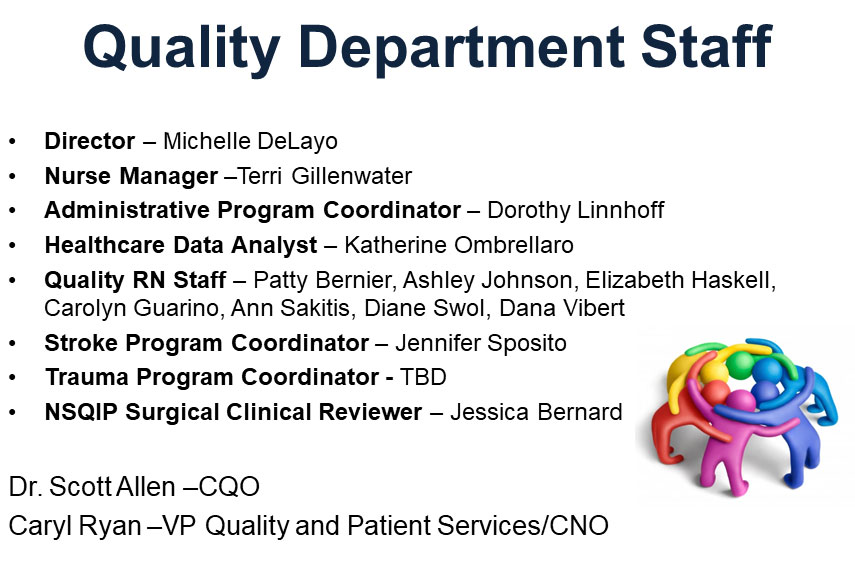A commonly used word in the world of business, “quality” has additional meaning in a patient care setting, and the UConn John Dempsey Hospital has a department dedicated to this. Director Michelle DeLayo and Dr. Scott Allen, UConn Health’s chief quality officer, explain how the UConn John Dempsey Hospital Quality Department works to maintain a safe and effective care environment. This year, Patient Safety Awareness Week is March 14 – 21.

What are we talking about when we talk about “quality” in a hospital?
MD: The goal of our quality department at UConn John Dempsey Hospital is to foster a culture where quality, safety, service, and improved performance are embraced by all members of the organization using a collaborative, interdisciplinary approach.
Quality management in health care works to reduce errors and improve patient care. The safety and effectiveness of treatment are two of the most critical measures of quality, and many roles within the department are dedicated to ensuring those outcomes are met.
How is quality measured?

SA: Some will look at external scorecards, such as Leapfrog Hospital Safety Grade as a “measure.” One has to be careful in that the correlation between the various scorecards is poor — you can perform well on one and poorly on another.
For Patient Experience, we survey patients (HCAHPS, CGCAHPS) or call them through our post-discharge phone follow-up process. We follow our patient grievances in terms of the number and how quickly we resolve them.
MD: Quality outcomes are measured in many ways. For instance, CMS (The Centers for Medicare and Medicaid Services) uses quality measures in its quality improvement, public reporting, and pay-for-performance programs. This includes core measure reporting, promoting interoperability (use of an electronic health record for prescribing, health information exchanges, patient to provider exchanges, etc.), and value-based purchasing. Quality is also measured in terms of patient safety, such as serious safety events, near-miss events, as well as other patient safety indicators (PSIs) such as post-op sepsis, deep vein thrombosis, and iatrogenic pneumothorax.
What is the Quality Department’s charge and how does it approach this?
MD: The quality department is comprised of 12 staff at present. This includes our nurse manager who just started and is charged with oversight of the department, our administrative program coordinator who is the glue that truly holds the department together, and a data analyst who has been phenomenal with working with all the different components of data which has allowed us to predict potential areas of vulnerability from a quality perspective as well as tell the story behind many of the performance improvement projects the department is working on.
The quality department is also called upon to assist with regulatory compliance activities such as scribing when regulatory bodies arrive at JDH, and participate in regulatory rounding as well.
Who’s on the team and what are their roles?

MD: Each of the staff have a primary role and also serve in a back-up role so that we continually have the institution covered with all things patient safety and quality.
We have 7 QA specialist nurses who oversee the following programs or PI projects: safety event analysis including our ACA on the road project, safety coach program, sepsis program, core measures, Promoting Interoperability program, value based purchasing program (QHIP), falls reduction, and glucometric PI. In addition we participate with the STS database (cardiothoracic surgery data reporting), assist with the NICHE program, and work with the cancer center on their yearly PI projects.
We also have a stroke program coordinator who facilitates the entire stroke program and abstracts data for the “Get with the Guidelines” database for stroke, and we have a NSQIP surgical clinical reviewer who specializes in data abstraction for our surgery population with associated PI opportunity identification.
In addition we have a trauma program coordinator who is charged with bringing Level III trauma certification to UConn, however that position is currently unfilled and posted in our job postings.
Lastly, all members of the department receive specialized training to conduct root cause analyses when the need arises, and many of the staff were asked to assist clinical operations with temporary returns to bedside practice within the ED, ICU, COVID testing tent, and cath lab during COVID.
How can the rest of us support the Quality Department’s mission and our overall quality objectives?

MD: One of the best ways everyone in the institution can support the quality department’s mission is to practice within a high reliability environment. That means utilizing all the tools you were taught through “Safety Starts With Me” training. Always place patient safety above all else, and submit safety events through the SI system whenever you notice an actual or potential safety event. The best way to keep our patients safe is to prevent errors from reaching them, so reporting a near miss is the most crucial step in high-reliability practice.
Also, when clinical staff are approached by quality department staff, perhaps our stroke program coordinator or one of our sepsis nurses, please be open to their constructive feedback and education.
What else should we know about our institution’s commitment to quality?
SA: I am involved with training faculty, residents and medical students in various capacities regarding patient safety and quality improvement. We are weaving this into the curriculum for all trainees, thus preparing all our learners for medical careers that must include a focus on quality and safety.
MD: UConn Health’s commitment to quality and patient safety is evident through our mission, vision, and values, as well as the many awards and recognition that have been ascribed to UConn Health. We strive to provide innovative and excellent care for our patients. We are never satisfied with the status quo and we continually benchmark ourselves both internally as well as externally against both state and national standards.
The quality department staff is always open to novel ideas to foster quality and performance improvement to assist the institution in achieving the highest quality and patient safety metrics.
I am quite proud to work with this great group!



